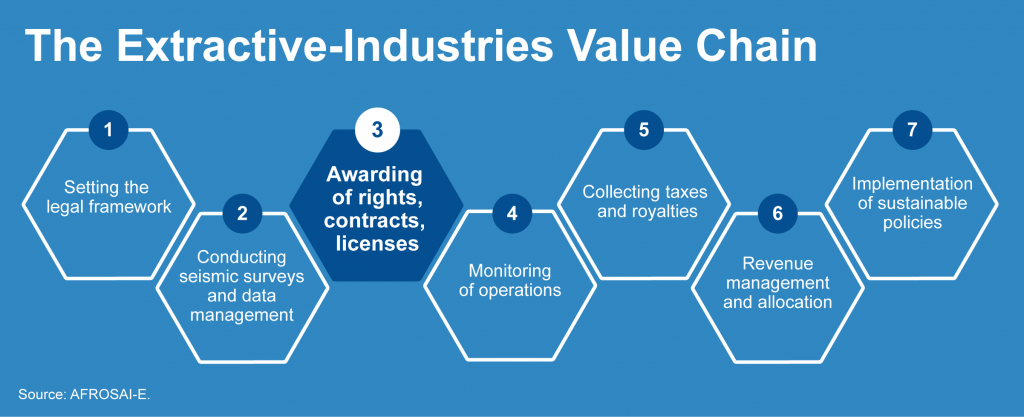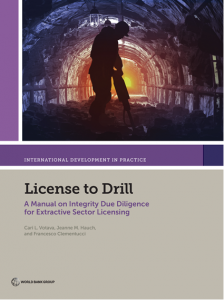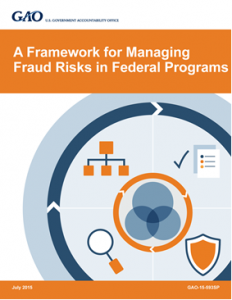A new resource from the World Bank’s Financial Integrity Unit is now available and could be of assistance to Supreme Audit Institutions (SAI) when conducting audits using the extractive-industries value chain.[1] The value chain describes the different steps of the development process, from discovery through extraction, to lasting value creation for society.[2] An important step in the value chain is the award of contracts and licenses. The World Bank’s License to Drill: A Manual on Integrity Due Diligence for Licensing in Extractive Sectors (Manual) is a toolkit of recognized concepts, good practices, and efficient options for policymakers and practitioners seeking to implement or improve integrity-screening systems in extractive sectors. The introduction of the manual underscores that, although the causes can be complex, there is widespread agreement that regulatory governance systems lacking transparency and having weak oversight and enforcement institutions facilitate an environment where rent-seeking and corruption thrive.

Coauthor of the Manual and Senior Financial Sector Specialist for the World Bank Cari Votava described it as a tool to improve quality and transparency of integrity due-diligence components of regulatory governance in the extractive sectors. Ms. Votava explained that, although there are many points in the extractive-industries value chain where corruption vulnerabilities can emerge, licensing decisions are perhaps the most critical. She noted that few countries can benefit when unsavory persons are granted licenses to operate in extractive sectors.
Desk Manual Aims to Reduce Corruption Risks during Licensing
 One of the overarching goals of the Manual is to identify good-practice options for reducing corruption risks in extractive industries by outlining methods to improve the licensing process, both to maximize the quality of entrants and to improve transparency at an early stage in the value chain. Before extractive licenses are granted or renewed, it is important to know who exactly the potential recipient is, including the beneficial owner, or natural person who ultimately owns or controls a legal entity or benefits from its assets. An effective and transparent licensing process can filter out many parties who might not act in a responsible manner, and it may have a positive impact on economic returns. Specifically, the Manual offers options for implementing effective and low-cost integrity-screening systems such as
One of the overarching goals of the Manual is to identify good-practice options for reducing corruption risks in extractive industries by outlining methods to improve the licensing process, both to maximize the quality of entrants and to improve transparency at an early stage in the value chain. Before extractive licenses are granted or renewed, it is important to know who exactly the potential recipient is, including the beneficial owner, or natural person who ultimately owns or controls a legal entity or benefits from its assets. An effective and transparent licensing process can filter out many parties who might not act in a responsible manner, and it may have a positive impact on economic returns. Specifically, the Manual offers options for implementing effective and low-cost integrity-screening systems such as
- criminal-background checks,
- beneficial-ownership checks, and
- conflict-of-interest checks.
International Frameworks Provide Potential Audit Criteria
International frameworks provide potential criteria for SAIs to use when reviewing issues related to the extractive-sector value chain. For example, the Manual uses the “fit and proper” concept from Principle #5 on Licensing of the Basel Core Principles for Effective Banking Supervision as criteria for ways to improve the quality of entities entering the extractive sector.[3] The fit and proper principle requires systemic and thorough integrity background checks on banking-license applicants, including documenting the identity of the beneficial owners of entities seeking bank charters.
Additionally, the Manual uses Extractive Industries Transparencies Initiative (EITI) Requirement #2 as criteria.[4] EITI Requirement #2 obligates countries to publicly disclose the identity of beneficial owners, among other things. According to the Manual, the disclosure of beneficial ownership requires the identification and verification of identity, which is done best before licenses are granted.

An additional framework that may be of use to SAIs when they consider corruption-related fraud risks during the awarding of contracts and licenses is the U.S. Government Accountability Office’s (GAO) publication A Framework for Managing Fraud in Federal Programs (Fraud Risk Framework).[5] According to GAO, fraud is obtaining something of value through willful misrepresentation.[6] The Fraud Risk Framework, which was issued in July 2015, identifies leading practices to help program managers combat financial and nonfinancial fraud.[7] It also can be a useful source of criteria for SAIs in conducting program audits. Among other steps, the Fraud Risk Framework emphasizes the need for programs to plan regular fraud risk assessments and assess risks to determine a fraud risk profile. As part of assessing risks, managers are to determine where fraud can occur and the types of fraud the program faces, such as fraud related to financial reporting, misappropriation of assets, or corruption. Managers may consider factors that are specific to fraud risks, including incentives, opportunity, and rationalization to commit fraud. Additionally, the Fraud Risk Framework emphasizes that entities should design and implement a strategy with specific control activities to mitigate assessed fraud risks and collaborate to help ensure effective implementation. Lastly, the Fraud Risk Framework directs managers to evaluate outcomes using a risk-based approach and adapt activities to improve fraud risk management.
By the US Government Accountability Office
[1]Cari L. Votava, Jeanne M. Hauch, and Francesco Clementucci, License to Drill: A Manual on Integrity Due Diligence for Licensing in Extractive Sectors (Washington, D.C.: International Bank for Reconstruction and Development / The World Bank, 2018). https://openknowledge.worldbank.org/bitstream/handle/10986/29809/9781464812712.pdf.
[2]African Organization of English-speaking Supreme Audit Institutions, Guideline: Audit Considerations for Extractive Industries (November 2015).
[3]Basel Committee on Banking Supervision, Core Principle for Effective Banking Supervision (Basel, Switzerland: Bank for International Settlements, 2012). https://www.bis.org/publ/bcbs230.pdf.
[4]Extractive Industries Transparency Initiative, The EITI Standard 2016 (2017). https://eiti.org/eiti-requirements#eiti-requirement-2.
[5]GAO, A Framework for Managing Fraud in Federal Programs, GAO-15-593SP (Washington, D.C.: July 28, 2015). https://www.gao.gov/assets/680/671664.pdf.
[6]GAO, Standards for Internal Control in the Federal Government, GAO-14-704G (Washington, D.C.: September 2014). https://www.gao.gov/assets/670/665712.pdf. The Committee of Sponsoring Organizations of the Treadway Commission (COSO) updated its internal-control guidance in 2013 with the issuance of a revised Internal Control—Integrated Framework. GAO’s Standards for Internal Control in the Federal Government adapts principles in the COSO guidance for the government environment, such as requiring managers to consider the potential for fraud when identifying, analyzing, and responding to risks.





